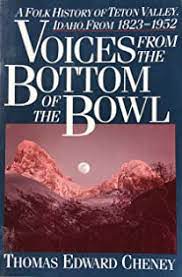Articles/Essays – Volume 27, No. 3
Memory and Familiarity | Thomas Edward Cheney, Voices from the Bottom of the Bowl: A Folk History of Teton Valley, Idaho, from 1823-1952
This collection of reminiscences about life in a tiny southern Idaho com munity has such an authentic flavor of small-town Mormon country, a flavor which I did not experience first-hand but at a second-generation level through stories told by my parents, that they struck a deep chord of emotional familiarity. Therefore, it is difficult to be completely objective about this book—I enjoyed it immensely. So now that readers understand my point of view, I will attempt to step back a bit and be at least somewhat objective.
Thomas E. Cheney is probably best known for the collection of Mormon folk music he compiled. In this new book he turns to his own family and community folklore and becomes a teller of tales. He makes no claims of historical accuracy: all of his stories are colored by memory, with a strong personal voice. He writes, “The stories are accurate as memory is accurate, biased as morals may be biased, and romanticized as time and imagination unconsciously romanticizes” (1). There is, indeed, some romanticism to the narratives, but recognized as such it does not detract from the good read that this book is.
This collection brings to mind the recent work of folklorist William A. Wil son, who has compared family narratives to the best novels. They have recurring characters whom we get to know better as they appear in successive stories; they have settings that influence the action in the narrative; and the threads of character, setting, and inter-weaving plots bind the vignette-like narratives into a coherent story (William A. Wilson, “Personal Narrative: The Family Novel,” Western Folklore 50 [Apr. 1991]: 127-49).
Characters are keenly drawn in this book—we quickly become familiar with Cheney’s mother, his stepfathers (his father died of an infected tooth three months before Thomas was born), the town pranksters, Whispering Ed (whose normal speaking voice was so loud that an ironic nickname was called for), the murderous bartender, the adulterous postmaster-cum-Sunday school president, and the other citizens of Vic tor, Idaho. We read of ear-splitting profanities coming out of the same mouths that offer humble prayers to God, and we see the human weaknesses which sometimes lead to regrettable occurrences.
One of the most affecting stories is “Red Hair in the Sacred Grove,” about a young woman who came to town to teach high school in 1918. She was not Mormon, and her first words upon alighting from the train, “My God, what a dump,” soon were all over town. The story describes her efforts to expose her farm-bred students to the great artists in history, but in moments of frustration she uses mild profanity, chastises the students for their self-righteousness, and says, “You think your Eliza Snow is a greater musician than Handel. You probably have never heard of Rembrandt, but if you had you would think that that sloppy painting of The Sacred Grove above the pulpit in your chapel is greater than his Christ Healing the Sick. You have raw aesthetic sense, no concept of beauty. You people in this class will not allow yourselves to like Chaucer—my God, what poverty” (55).
While Miss Spurns awakened in young Thomas a new appreciation for literature and ideas, and he had a con versation with her about his interests, he later caved in to peer pressure and signed a student petition demanding her resignation after the school board had confirmed their support of her. She was on the train that night, abandoning a copy of Othello which she had loaned him, and which he still possesses, calling it “a chronic chastisement to my sensitivity” (53).
These are folk narratives dressed up to go to town. The stories, when told orally, are undoubtedly simpler, with less of a literary quality. There is no fault in the literary turn, but this is not folk style—it is folk material, however. In general, the book is beautifully written, with only one or too lapses into over blown or cliched prose. Much of the dialogue clearly reflects the kind of blunt understatement common to the West: After the death of a woman in childbirth, the widowed husband comes to Thomas’s stepfather, who is building the coffin. “‘Pete,’ the man said in a loud, gruff voice, ‘1 want you to make the coffin big enough for the baby too.’
“Is it dead?’ Pa asked.
“‘No, it ain’t dead, Pete, but it can’t live without a mother.’ Pa turned to me and said, ‘Thomas, it is your bedtime. Go'” (12).
In this collection are insights into social structure, hardships, and conventions of early twentieth-century Mormon country. There is delight in recognition for those whose histories include similar stories, and readers see how the sacred and profane sides of life intermingle and interact in a close community. Folk customs and beliefs ap pear here and there. Thomas Cheney was born with the “veil”—part of the inner membrane of the uterus—wrapped around him. The midwife who delivered him apparently told his mother that a child wrapped in the veil would be a special person. A poem is included (8), referring to the death of Thomas’s father and Thomas’s birth with the veil, but it is not clear that the midwife wrote the poem. Nor is it clear whether the poem was left by the midwife or written later by someone else. Finally, without an index the book is not as useful to scholars as it could be.
Voices from the Bottom of the Bowl is a delightful reminiscence for all readers, with scholarly uses similar to those of other personal histories and memoirs.
Voices from the Bottom of the Bowl: A Folk History of Teton Valley, Idaho, from 1823-1952. By Thomas Edward Cheney (Salt Lake City: University of Utah Press, 1991).


 Back to full Issue
Back to full Issue

